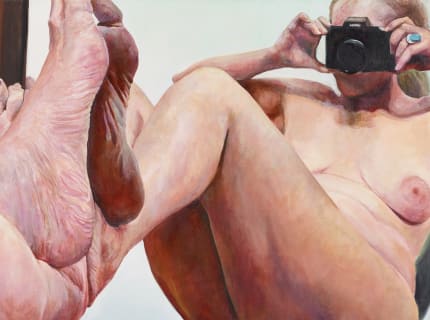Although she started out as an abstract painter, Joan Semmel’s career has come to be understood primarily in terms of the radical figurative paintings she has been creating since the 1970s. In the midst of a year of renewed visibility (with work on view in exhibitions at Alexander Gray Associates, Cheim & Reid, the Whitney, and Dallas Contemporary, among others), Semmel welcomed Laila Pedro to her New York studio to reflect on her process, her position in feminist art history, and her perspective on aging before her own painterly gaze.
Laila Pedro (Rail): Before coming to your studio, I was thinking a lot about the particularly freighted significance of language in talking with you and about your work. There is a lot of otherwise rigorous writing about women artists of the past two generations that is (I hope inadvertently) profoundly condescending, in that it assumes a tone of discovery or surprise. Do you feel affected by this kind of ahistorical interpretation?
Joan Semmel: Oh, of course. What you see so much is suddenly they’ve discovered women artists, and suddenly they’re old women artists. Why do you think they didn’t discover them until they were old? Not because the work wasn’t there. It’s because they weren’t interested in promoting, or showing, or thinking about what women were doing. And it’s unfortunate, but that’s how it’s been. I think that now there’s a whole new surge of interest in women’s work—and it’s not the first time.
Rail: In your artist talk before the opening of your solo show this fall at Alexander Gray, you made the point about there being this cyclical resurgence of interest in women. After that talk I went back and read something I hadn’t read in a very long time, which was Susan Faludi’s book from the ’90s, Backlash, because it is so true; there’s a glimmering moment of potential liberation and then it snaps right back.
Semmel: It goes right back—and you start again. And a lot of what you start again with is the same thing that was there to begin with. At the same time, and even as I am happy to see how many new young women artists are out there, I am bothered by recycling the same things. It may be a bounce-back, but it’s also a different situation now. In the early ’70s we were having panels and discussions and asking, What is feminist art? There was a lot of argument about it; a lot of women stepped back from the whole movement because they didn’t want to be classified that way. And we were trying to define the kinds of things that art was outside of the mainstream conceptions. I think much of what happened then did, and continues to, profoundly influence the art world. Right now it’s like some of the men are doing what some of the women were doing.
...
Read full article at brooklynrail.org.

